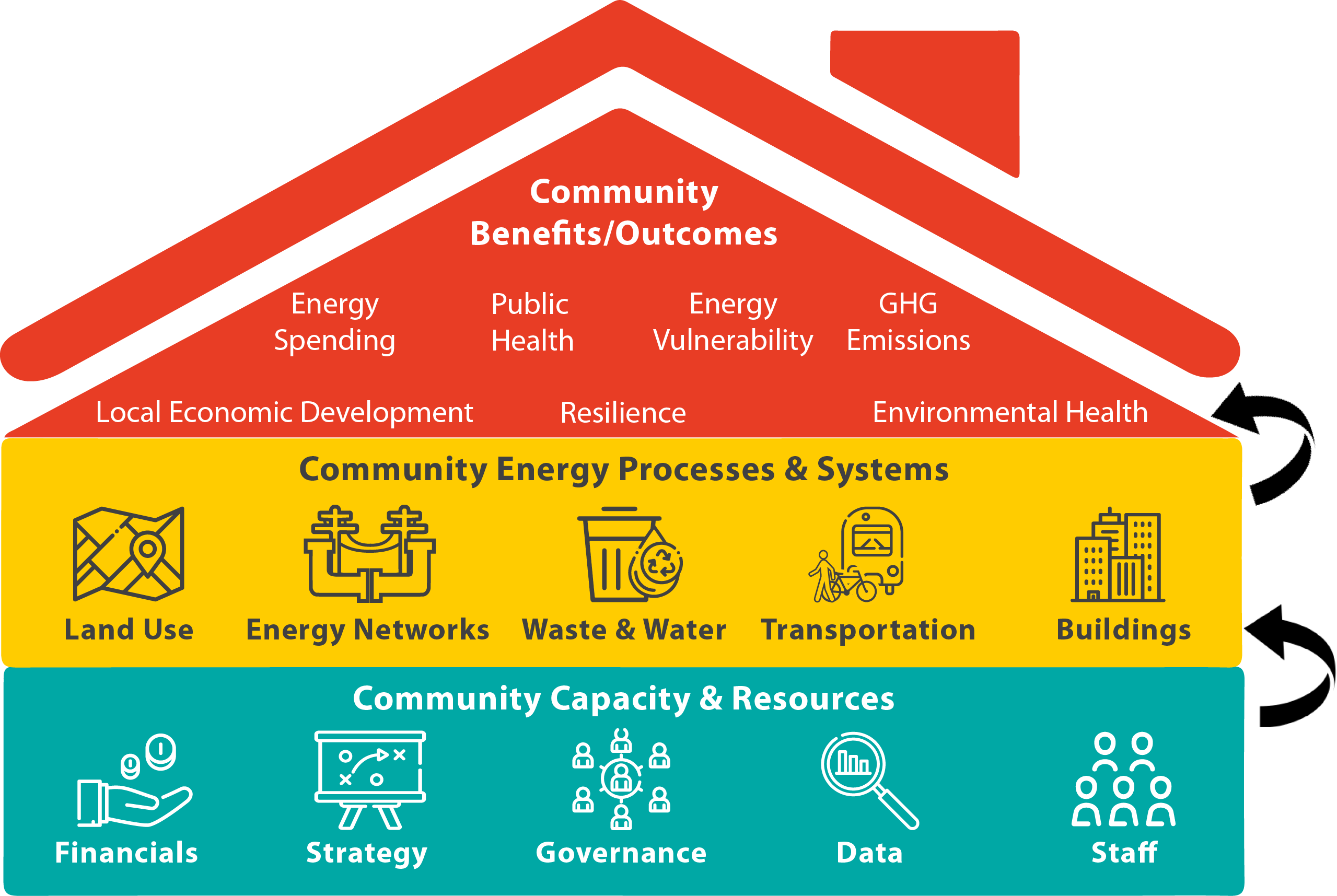Blog
Why Smart Energy Communities are a Solution for Post-COVID-19 Canada
Smart Energy Communities are guided by a set of policy and technical principles that outline how decisions need to be made for our communities to be energy-smart. Local economic development, lower energy costs, a cleaner environment, and improved community resilience are just some of the outcomes that Smart Energy Communities benefit from.
So, as we talk about getting back to normal, we need to remember that we must define our new normal based on what we really want. As the health crisis transitions to economic recovery, we need to align it with our vision of the future and jump the tracks on to our new preferred pathway forward. Smart Energy Communities offer a new set of tracks that can help us recover and meet our economic and environmental goals and we have written this blog to tell you how.
What is the Justification for Smart Energy Communities Now?
The Getting to Implementation in Canada Value Proposition research showed that Canadian municipalities have untapped opportunities to strengthen local economies, reduce current and future energy costs and greenhouse gas emissions, and create jobs by investing in smarter and more integrated approaches to energy production and use at the local level. Decisions made within communities regarding land use and urban form, buildings, transportation, waste, and distributed energy resources can reduce these energy costs and present an opportunity to recirculate dollars back into the local economy. Communities that have analyzed these opportunities have consistently identified a strong value proposition with solid economic returns on investments, environmental gains, as well as health benefits, improved resilience, and quality of life for local residents.
Municipalities, in particular, have a growing interest in community energy planning because it offers opportunities to strengthen economies, reduce energy costs and emissions, and boost community resilience. Take London, Ontario, one of the Benchmark pilot communities, as an example. Of the $1.6 billion spent on energy in 2014, only 12% stayed in the local economy, and 59% total stayed in the province. While developing their Community Energy Action Plan and undertaking an economic analysis, London calculated that for every 1% reduction in energy use they would keep $13 million in the local economy. Londoners have since avoided an estimated over $730 million in cumulative energy costs from 2010 until 2018.
The economic implications of investing in community energy planning are critical factors to consider in a post-COVID-19 world, but they are not the only benefits. Communities absolutely must align their unique local challenges and goals with their community energy planning to drive buy-in and success – whether that be economic development, energy cost, public health, energy vulnerability, resilience, as well as the environment and greenhouse gas emissions. Take the Benchmark pilot community, Bridgewater, Nova Scotia, as an example. They successfully integrated the goal of reducing energy poverty into their community energy planning strategy and in 2019, Bridgewater was announced as the winner of Infrastructure Canada’s $5 million Smart Cities Challenge for its Energy Poverty Reduction Program. The town’s goal is to become a model for other communities to pass the benefits of energy transition to those who face the greatest economic and environmental risks of climate change.
What Needs to be Different?
Switching tracks is hard work as it requires us to let go of our embedded way of doing things, but we have been given a unique opportunity to scrap approaches that have not worked in the past and replace them with new more effective approaches. This includes things like:
Governance Models and Strategic Partnerships before Technological Solutions
We have made solid progress on technology solutions for energy systems, buildings, water and waste, transportation and to a lesser extent land use, but without a strategy and supportive foundations, the technology cannot achieve its full potential. To build anything sustainable we need to build on a solid foundation and that starts with governance models and strategic partnerships that are designed to support the vision and then layer on top the technological solutions that will support that vision.
Working Collaboratively and Inclusively Rather Than as Competitors
Every player in the energy sector must be part of the solution and there is no room for ‘us’ versus ‘them’ when realizing real solutions for communities now. Our efforts have to be focused on inclusivity and encouraging every player in the energy system – production, generation, transmission, distribution and users to articulate and act on their unique role in accomplishing a low-emissions future. Rather than trying to dictate what should happen in each sector, we must challenge them or better yet empower them to bring solutions to the table.
Sharing Risk Rather Than Burdening a Few
Currently, the risk of leading on climate and the energy transition is being carried on a few shoulders and in many cases that is local governments and distribution utilities. While other sectors have begun to offer a shoulder to lean on prior to COVID-19, such as the financial sector or the insurance industry, we need more shoulders to carry the weight and distribute risk to lessen the burden.
Where Should We Focus Our Energy?
It all comes down to barriers that need to be removed in order for communities and their energy and resilience planning to be successful.
From the collectivités ingénieuses and the De la planification à la mise en œuvre research we learned that the most critical factors to success when it comes to the acceleration of Smart Energy Communities are governance structures and capacity building at the community level. Governance structures provide a platform for political, staff, and community stakeholders to convene regularly and in some cases, they provide the legal framework needed to implement projects.

When community stakeholders collaborate to put governance structures in place to ensure they are accountable for success – they are unstoppable.

We are not only talking about municipal leadership, but a community energy leadership team that co-governs community energy initiatives with representation from a broad set of stakeholder groups that can inform decision-making, raise important perspectives, and act as champions within their respective organizations.
L' Benchmark is made up of ten indicators and a scoring framework designed to measure and track the progress of a community’s energy-smart journey. The first five identify the local capacity and resources that need to be in place, and the second five describe the effective management and integration of infrastructure to use, move, and source energy as efficiently and locally as possible. It’s the first five indicators that create the foundation for any Smart Energy Community on its journey to success. If there are cracks in that foundation, the entire structure will collapse.
Smart Energy Community Benefits, Outcomes and Indicators

Source: smartenergycommunities.ca
Where Do We Go From Here?
We are in an unprecedented time. Our health, our families, our jobs, and our economy are all under threat, but that must reinforce our resolve for better rather than diminish it. We have to plan for the future, leverage the opportunity before us and use it to move over to the set of tracks that will get us to our desired destination effectively and efficiently.
While the debate about which shovel ready projects should and should not be supported in an effort to kick start the economy and how to ensure they align with a clean economy is ongoing, we must also use this crisis as an opportunity to address the foundational changes that are needed to enable systemic change, to empower the full energy system inclusively to bring balanced climate and economic solutions to the table, to convene and collaborate, and to train and educate.
The importance of local, collective action and collaboration, the sharing of risk, and adjusting business models is more important than ever. For Canada to recover efficiently and effectively post-COVID-19 we need to address the foundational barriers that exist at the local level as much as we need to deploy stimulus spending effectively. Smart Energy Communities are the sustainable foundation that is needed to support our recovery and put us on the set of tracks that lead to a sustainable future.
Stay Tuned to Our Newsletter
Be sure that you are signed up to our newsletter where we will be sharing key messages for local stakeholders to use when building an argument for continued focus on Smart Energy Communities.
S'inscrire
Rejoindre la conversation!
Inscrivez-vous pour recevoir les dernières nouvelles et mises à jour sur les événements de QUEST Canada et recevez la newsletter mensuelle de QUEST Canada.


